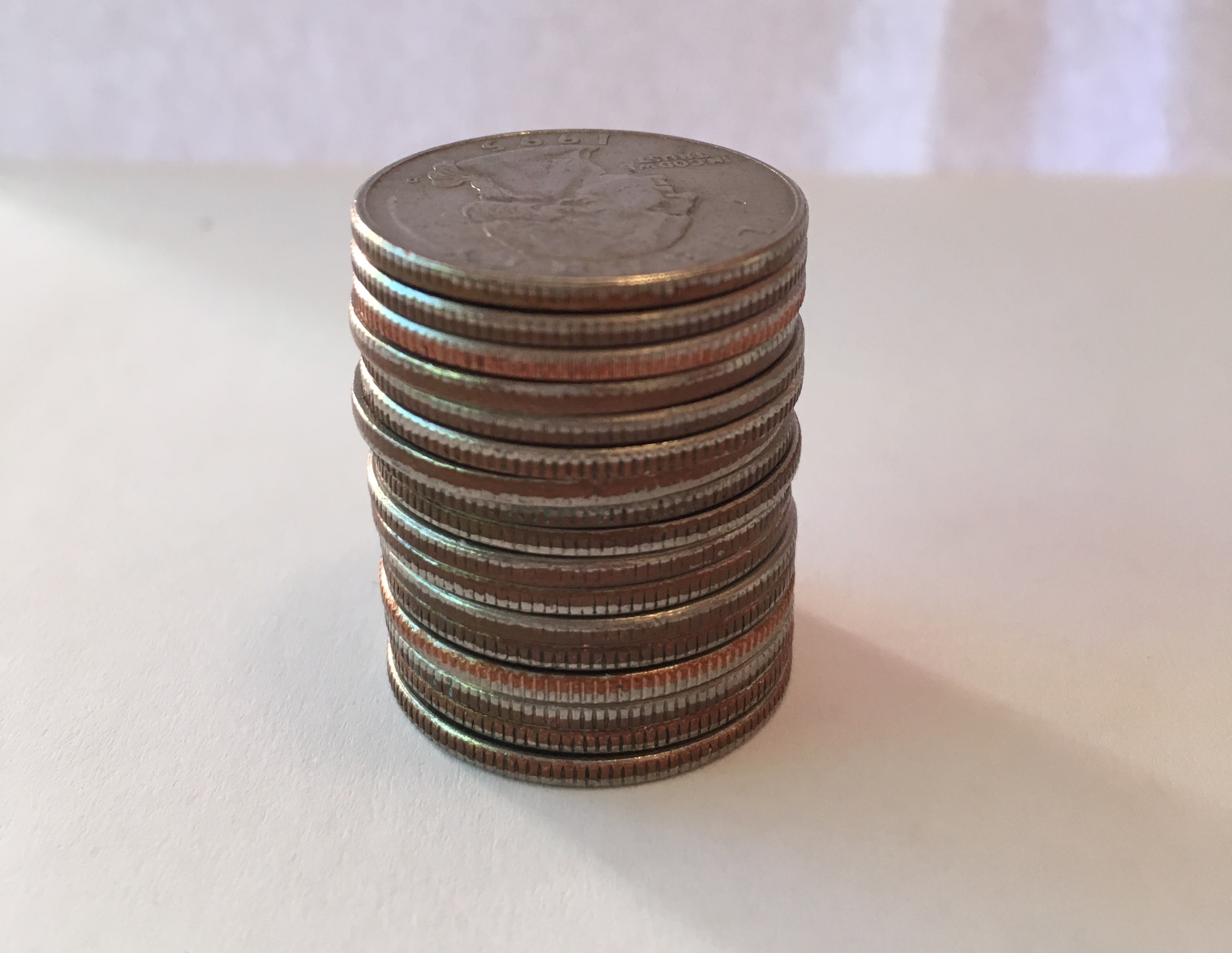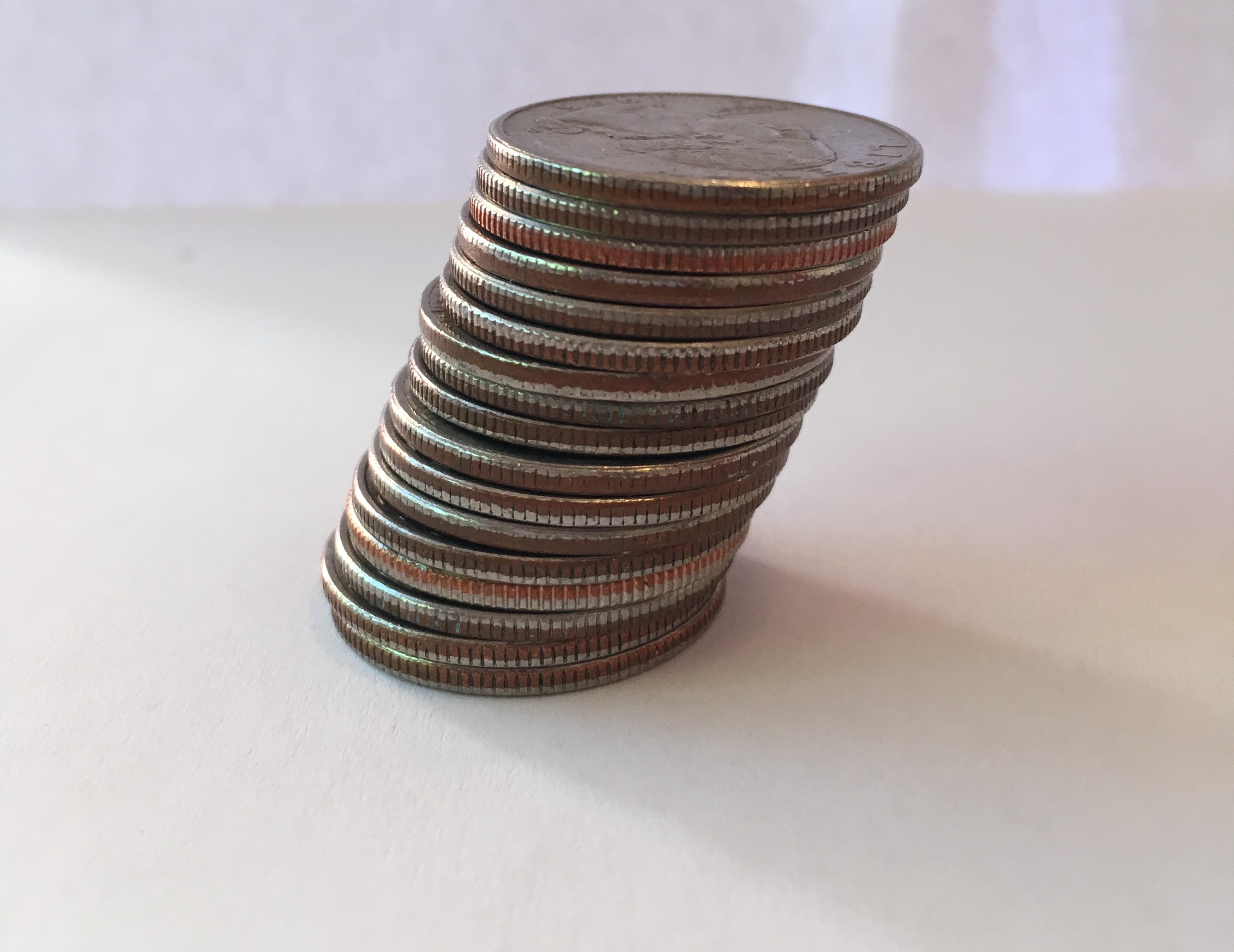Lesson 10
Cross Sections and Volume
10.1: Two Stacks of Coins (5 minutes)
Warm-up
In this warm-up, students encounter the concept of right and oblique cylinders. They begin thinking about volume relationships in terms of cross sections. This helps prepare them to give informal arguments for cylinder, cone, and pyramid volumes.
Launch
Arrange students in groups of 2. Give students quiet work time and then time to share their work with a partner. Follow with a whole-class discussion.
Student Facing
The images show the same number of coins arranged in different ways.
A

B

- How are the two coin stacks different from each other?
- Does either stack of coins resemble a geometric solid? If so, which stack and what solid?
- How do the heights of the two stacks compare?
- How do the volumes of the two stacks compare? Explain your reasoning.
Student Response
For access, consult one of our IM Certified Partners.
Activity Synthesis
The goal of the discussion is for students to recognize that the two stacks of coins have the same volume, and to learn vocabulary words to describe each type of solid.
Tell students that the coin stack A resembles a right cylinder, while coin stack B resembles an oblique cylinder. Challenge students to create definitions for these terms: a right cylinder has its curved face at right angles to its base, while the oblique cylinder has non-right angles.
Emphasize that the heights and volumes of the two stacks are the same.
10.2: Rectangular Prism, Shifted (15 minutes)
Activity
In this activity, students conclude that an oblique prism and a right prism that have the same height and whose bases are of equal area have the same volume, because their cross sections at all heights have equal area. This is Cavalieri’s Principle. It will be used in developing the pyramid volume formula.
This activity works best when each student has access to devices that can run the GeoGebra applet because students will benefit from seeing the relationship in a dynamic way. If students don’t have individual access, projecting the applet would be helpful during the synthesis.
Launch
Provide students with access to internet-enabled devices.
Show students a tall stack of index cards. Ask students:
- “What geometric solid does the stack of cards resemble?” (A right rectangular prism.)
- “What is the shape of the base?” (A rectangle.)
- “What is the shape of any cross section taken parallel to the base?” (All of the cross sections are rectangles congruent to the base.)
Now shift the cards to create an oblique rectangular prism. Ask students if the shape of the base or the shape of the cross sections has changed. Emphasize that each cross section is still congruent to the rectangular base. Tell students that in this task they will be working with a prism that gets shifted in the same manner as the index cards.
Design Principle(s): Maximize meta-awareness; Support sense-making
Student Facing
The applet shows two rectangular prisms. Each prism’s base has area \(B\) square units, and the prisms are the same height. A plane intersects the two prisms parallel to their bases, creating cross sections.
- Sketch the two cross sections. How do their shapes and areas compare to each other?
- Use the applet to investigate the behavior of the prisms by sliding the “move base” and “change skew” sliders. Investigate the behavior of the cross sections by sliding the “move plane” slider. How do the shape and area of the cross sections change when you move the plane up or down?
- How do the volumes of the two prisms compare? Explain your reasoning.
Student Response
For access, consult one of our IM Certified Partners.
Student Facing
Are you ready for more?
The image shows a recomposition of a solid.

How does this demonstrate Cavalieri's Principle?
Student Response
For access, consult one of our IM Certified Partners.
Launch
Show students a tall stack of index cards. Ask students:
- “What geometric solid does the stack of cards resemble?” (A right rectangular prism.)
- “What is the shape of the base?” (A rectangle.)
- “What is the shape of any cross section taken parallel to the base?” (All the cross sections are rectangles congruent to the base.)
Now shift the cards to create an oblique rectangular prism. Ask students if the shape of the base or the shape of the cross sections has changed. Emphasize that each cross section is still congruent to the rectangular base. Tell students that in this task, they will be working with a prism that gets shifted in the same manner as the index cards.
Design Principle(s): Maximize meta-awareness; Support sense-making
Student Facing
The image shows two rectangular prisms. The bases of the prisms are congruent. Each base has area \(B\) square units, and the prisms are the same height. A plane intersects the two prisms parallel to their bases, creating cross sections.

- Sketch the two cross sections. How do their shapes and areas compare to each other?
- How would the shape or area of the cross sections change if we moved the plane up or down?
- How do the volumes of the two prisms compare? Explain your reasoning.
Student Response
For access, consult one of our IM Certified Partners.
Student Facing
Are you ready for more?
The image shows a recomposition of a solid.

How does this demonstrate Cavalieri's Principle?
Student Response
For access, consult one of our IM Certified Partners.
Anticipated Misconceptions
Some students may not be convinced that the cross sections don’t change shape when the figure is made oblique. Remind them of the index cards and the stack of coins, and ask them how those examples relate to this situation.
Students may believe that the cross sections of the oblique prism are parallelograms. Ask them to think back to the two stacks of coins and the shifted stack of index cards, and to consider whether the shape of the coins or the cards changed when the stack was shifted.
Activity Synthesis
The goal of the discussion is for students to understand that if two solids of the same height have equal-area cross sections at all heights, the solids have equal volumes. Remind students about the stack of index cards from the activity launch. Ask them:
- “When we shifted the stack of index cards so that it was oblique, did the volume change? Why or why not?” (No. The stack has the same number of cards no matter how it’s arranged.)
- “How can you phrase your explanation in terms of cross sections?” (The individual index cards are like cross sections. Shifting them sideways doesn’t change their area, so the total volume doesn’t change.)
- “What if we had a stack of circular cards, and each card had the same area as the rectangular cards in this stack? How would its volume compare to this rectangular card stack’s volume?” (The volumes would be the same. Each circular card has the same area as the rectangular card, so when we stack up equal numbers of them, we get equal volumes.)
Tell students that this idea was developed by a mathematician named Bonaventura Cavalieri, so it’s called Cavalieri’s Principle. This principle can be proven, but the proof is beyond the scope of this course. Ask students to add this theorem to their reference charts as you add it to the class reference chart:
Cavalieri’s Principle: If two solids are cut into cross sections by parallel planes, and the corresponding cross sections on each plane always have equal areas, then the two solids have the same volume. (Theorem)

Supports accessibility for: Memory; Language
10.3: Equal Volumes? (15 minutes)
Activity
In this task, students develop their ability to analyze solids of different obliqueness and cross-sectional shape. They use Cavalieri’s Principle to identify solids of equal volume. This concept will be helpful in upcoming lessons when students develop a formula for the volume of a pyramid.
As students work, monitor for groups that calculate actual volumes, and for those who use the vocabulary of cross sections or other logical deduction methods.
Students have the opportunity to look for and make use of structure (MP7) as they identify fundamental characteristics of solids such as base area and height.
Launch
Arrange students in groups of 2.
Design Principle(s): Optimize output (for explanation); Maximize meta-awareness
Supports accessibility for: Organization; Attention
Student Facing
For each pair of solids, decide whether the volumes of the two solids are equal. Explain your reasoning. If you and your partner disagree, discuss each other’s approach until you reach agreement.
Student Response
For access, consult one of our IM Certified Partners.
Activity Synthesis
The purpose of the discussion is to solidify the notion that objects with equal-area cross sections and the same height have the same volume, regardless of how “oblique” the solids are or if the cross sections have different shapes.
As each pair of solids is discussed, invite students who have used different strategies to present their work. For example, students may have calculated volumes, or they may have used the language of cross sections and heights. If it doesn’t come up, ask students how Cavalieri’s Principle relates to these problems, as the concept of equal-area cross sections at all heights will be used in upcoming activities. It’s not critical that students memorize the name of the principle, but they should know how the concept relates to this task.
Lesson Synthesis
Lesson Synthesis
In this lesson, students explored right and oblique solids, and related Cavalieri’s Principle to the volumes of such solids. Display this image for all to see:

Ask students:
- “Can you identify a right cylinder that would have the same volume as this one?” (One option would be to have the same radius and a height of 25.)
- “Is there any measurement on this diagram that you would not use when calculating the volume?” (We wouldn’t use the 30.)
- “Calculate the volume of this cylinder mentally.” (The area of the base is \(100\pi\). Multiply that by the height to get \(2500\pi\) cubic units.)
In prior grades, students established that \(V=Bh\) for right prisms and cylinders; Cavalieri’s Principle now allows this to be extended. Ask students to add this theorem to their reference charts as you add it to the class reference chart:
A prism or cylinder whose base has area \(B\) square units and whose height is \(h\) units has volume \(Bh\) cubic units, regardless of the shape of the base or whether the solid is oblique. (Theorem)

10.4: Cool-down - Drawing Solids (5 minutes)
Cool-Down
For access, consult one of our IM Certified Partners.
Student Lesson Summary
Student Facing
Suppose we have a stack of paper in the shape of a rectangular prism. Then we shift the paper so the prism slants to the side. The first is called a right prism because its sides are at right angles to its base. The second one, without right angles between the sides and the base, is called an oblique prism. The volume of the prism doesn’t change when we shift it—the amount of paper stays the same.


In fact, Cavalieri’s Principle says that if any two solids are cut into cross sections by parallel planes, and the corresponding cross sections at all heights all have equal areas, then the solids have the same volume.
In this image, all measurements are in centimeters. The oblique cylinder and the right prism have equal volumes because they have the same height and their cross sections at all heights have the same area of 6 square centimeters.

These two pyramids also have equal volumes. Their bases are congruent, and they have the same height. Shifting a solid from right to oblique doesn’t change its volume.






